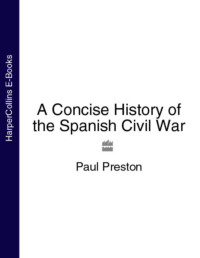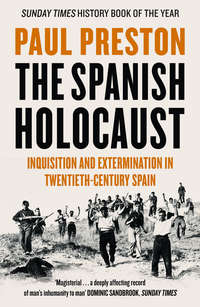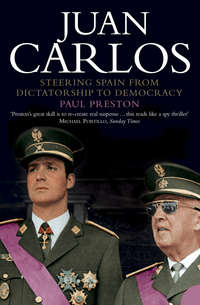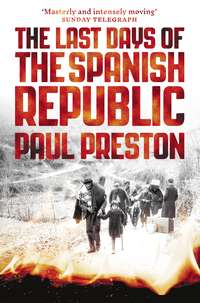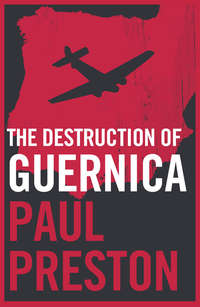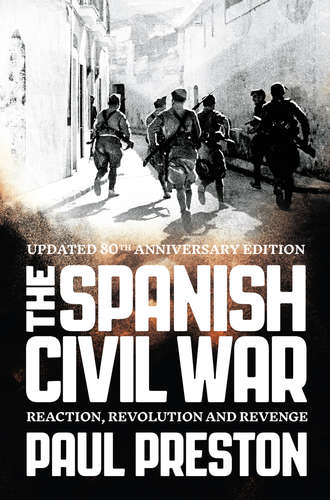
Полная версия
The Spanish Civil War: Reaction, Revolution and Revenge
In fact, in 1986, the fiftieth anniversary of the outbreak of a war which would see Spain suffer nearly forty years of international ostracism, the country was formally admitted into the European Community. Ten years later, the withering away of Francoism and continued consolidation of democracy were demonstrated when the Spanish government, with all-party support, granted citizenship to the surviving members of the International Brigades who fought against fascism during the Civil War. It was a welcome but belated gesture of gratitude and reconciliation which serves as a reminder of a violent and bloody Spain which has perhaps gone for ever.
It might therefore be expected that, by 2006, passionate interest in the Spanish Civil War would at last be fading. Indeed, the very opposite was the case. It was only in the early years of the twenty-first century that for many families a major area of unfinished business, the location, proper burial and mourning of their dead, has begun in earnest. It is a process that, for half of Spain, was completed more than sixty years ago. That it has been denied the other half of the country until so recently is one of the main reasons for the continuing ability of the Spanish Civil War to provoke passion.
On 26 April 1942 Franco’s government set in train a massive investigation called the ‘Causa General’. Its immediate objective was to gather evidence of Republican wrongdoing. The ‘material’ gathered ranged from documents to unsubstantiated hearsay. It was an invitation to all those with genuine grievances – the relatives of those murdered or those who had been imprisoned or had had property confiscated or stolen in the Republican zone – to vent their desire for revenge. It also permitted anyone with a personal score to settle or who coveted someone’s property or wife to smear their enemies. Although the procedures were lax in the extreme, the declarations made, substantiated or otherwise, were used to intensify the generalized image of Republican depravity. It was a part of a general pattern that had been seen since July 1936 in every part of the Nationalist zone as it fell to rebel forces. Once the Nationalists were in control, those rightists killed by the left were identified and buried with honour and dignity in ceremonies that were often followed by acts of extreme violence against the local left. In the case of extremely famous victims of the war, such as the Falangist leader José Antonio Primo de Rivera or the original leader of the military coup, General José Sanjurjo, their bodies were exhumed and then reinterred in elaborate ceremonies.
The consequence of these various procedures was that the large majority of the victims of crimes in the Republican zone were identified and counted. Their families could mourn them and very often their names were engraved in places of posthumous honour, inscribed in the crypts of cathedrals or on the external walls of churches, with crosses or plaques placed where they died or even, in some cases, with streets named after them. The structures of law and order disappeared in Republican Spain as a result of the military coup and it took several months for them to be re-established. Accordingly, the atrocities in the Republican zone were often the work of criminal elements or out-of-control extremists, although also, less frequently, of deliberate policy by leftist groups determined to eliminate their political enemies. This great variety of crimes was portrayed for nearly forty years by the propaganda machine of the victorious regime, written largely by policemen, priests and soldiers, as if it were the official policy of the Republic. The purpose of such writing was to justify the military coup of 1936, the slaughter it provoked and the subsequent dictatorship. Through the press and radio of the Movimiento, the education system and the pulpits of Spain’s churches, a single, monolithic interpretation of the Spanish Civil War was propagated. Until 1975, official propaganda carefully nurtured memories of the war and the bloody repression not only to humiliate the defeated, but also to help the victors recall what they owed Franco. For those who were complicit in the regime’s networks of corruption and repression, it served to remind them that they needed Franco and the regime as a bulwark against the return of their victims who, they imagined, would want to wreak bloody revenge.
For those on the left there had been no equivalent process of closure. There were thousands of the ‘disappeared’ (desaparecidos), their bodies not located, their manner of death not confirmed. Unlike the families of the Nationalist victims of Republican violence, the relatives of the Republican victims of the Nationalist repression could not mourn openly, let alone bury their dead. Even after the death of Franco, the problem of confronting the memory of the Civil War remained immensely difficult because the hatreds of the war had continued to fester for thirty-seven years after its formal conclusion. The dictatorship had imposed a single vision of the past but there were many other memories, hidden and repressed. Many thousands of families wanted to know what had happened to their loved ones and if, as they feared, they had been murdered, where their bodies lay. In the first months of the transition to democracy, fear of a new civil war wrestled with the desire to know about the Republican past. In the event, the drive to guarantee the re-establishment and, later, the consolidation of democracy weighed more both with politicians and with the bulk of ordinary people. The formal renunciation of revenge which was an essential precondition for change was enshrined in a political amnesty not just for those who had opposed the dictatorship but also for those guilty of crimes against humanity committed in the service of the dictatorship. The amnesty text of 14 October 1977 was supported by the majority within the political spectrum. The ghosts of the Civil War and of Francoist repression weighed on Spain, but to prevent the reopening of old wounds successive governments, both conservative and Socialist, were extremely cautious when it came to funding commemorations, excavations and research connected to the war.
The determination of the great majority of the Spanish people to secure a bloodless transition to democracy and to avoid a repetition of the violence of another civil war not only overcame any desire for revenge but also saw the sacrifice of the desire for knowledge. Thus, the ‘pact of oblivion’ saw a curtain of silence drawn over the past in the interests of a still-fragile democracy. Accordingly, there were not only very few official initiatives aimed at commemorating the past but also a certain reticence within the education system about teaching the history of the Civil War and its aftermath. Nevertheless, at a local level many historians continued to pursue research into the Francoist repression, and, for many victims, appearance in the lists compiled in their books was their only gravestone or memorial. Despite its crucial value in political terms and its importance as a measure of the great political maturity of the Spanish people, the pacto del olvido did not apply to historians. In fact, from the first, in La Rioja, in Catalonia and in Aragón, there had been considerable research into the most disagreeable aspects of the Civil War, despite the pacto. Elsewhere, the uneasy truce with the past was soon broken, with the appearance of several important works on the repression in Andalusia, Extremadura, Galicia and other regions that had found themselves within the Nationalist zone during all or part of the war. Over the last twenty years, what began as a trickle has become a torrent of books which, although written from many widely differing perspectives, has produced a generally critical vision of the insurrectionary officers of 1936.
In addition to the flood of historical works, in the same period, there has emerged a popular movement in favour of the detailed reconstruction of the war and Franco’s dictatorship at a local level. The creation of a series of organizations and associations dedicated to what has come to be called ‘the recovery of historical memory’. Several factors lay behind this development. On the one hand, there was a sense that democracy was now sufficiently consolidated to be able to withstand a serious debate about the Civil War and its consequences. Underlying this was also a terrible urgency driven by an awareness of the dwindling numbers of surviving witnesses. Without engaging in the thorny issue surrounding the fact that there are many different historical memories of the same events, it remains true that the concept of recovering memory has had a profound impact on a people whose collective memory was kept behind bars for so many decades. A process began involving the excavation of common graves (fosas), the recording of the testimonies of survivors and the proliferation of innumerable television documentaries about what happened. In consequence, today, eighty years after its outbreak, the Spanish Civil War and its aftermath are again generating passionate and, at times, bitter argument.
The breaking of the taboo associated with the pacto del olvido has had a dramatic and unexpected impact. The creation of associations dedicated to the recovery of historical memory and the efforts to locate the mortal remains of the disappeared have helped close the emotional wounds of many families. Newspapers regularly print accounts of exhumations. Barely a week passes without the publication of a detailed account of the repression in some town or province and the number of known victims is rising. Indeed, after years of such figures being reduced, they are now rising towards the levels once suggested by horrified eyewitnesses during and immediately after the war itself. In some places, ‘memory routes’ have been created along which it is possible to see places where atrocities or acts of resistance took place, all of which has created enormous discomfort, not just among the perpetrators or their relatives. The outrage provoked has extended even beyond those nostalgic for the dictatorship. It has also caused distress to extended sections of society which, over time, derived benefit from the regime. It is to this audience that a series of immensely successful historical polemics have been directed.
While there is at work a veritable army of serious researchers, there has emerged a small group of authors and broadcasters who barrack from the sidelines. Their cry is that the sufferings of Republican victims were notably less than has been claimed and that any such sufferings were, in any case, their own fault. Accordingly, the Spanish Civil War is being fought all over again on paper. These self-styled ‘revisionists’ allege that the historiographical advances of the last forty years, in all their infinite variety, are the result of a sinister conspiracy in which almost the entire historical profession and many amateur historians are involved. A wide range of historians from conservatives and clerics to liberals and leftists, as well as regional nationalists, are accused of linking arms to impose a monolithic and politically motivated interpretation of the history of the Spanish Civil War and the regime that followed it. There is little in terms of research that is new about the revisionist works. They resuscitate the basic theses of Francoist propaganda, of writers like Tomás Borrás, or the secret policemen Eduardo Comín Colomer and Mauricio Karl. In some cases, they have even recycled the titles of famous Francoist texts. The only thing that is new is the addition, in both books and inflammatory tertulias, or radio debates, of the techniques of reality television in insulting the authors of the new historiography rather than debating with them.
The consequence has been to introduce a level of abrasive tension to daily political discourse in Spain. The bulk of the historiography of the Civil War is comprised of more or less seriously researched history, which, unusually for such research, is feeding a popular demand. In contrast, the works of the revisionists have exactly the contemporary political purpose which they denounce in others. Their criticism of the Republic is implicitly a criticism of those of its values which have survived the dictatorship or been reborn in contemporary Spanish democracy. This is particularly the case with regard to the federal elements of Spain’s current structure, revisionist ire having been provoked by the fact that the present left-wing coalition government in Catalonia is actively sponsoring research into the repression. Even before this, the right had been outraged by the successful Catalan campaign for the return of tonnes of documents plundered by the Francoists in 1939. This documentation, housed in Salamanca, was originally seized to be scoured for names of leftists and liberals. Organized by archivists provided by the Gestapo, it was used, with similarly sequestered documentation from other conquered areas, to build up a file card index which became the infrastructural tool of the repression. In the view of the fiercely anti-Catalanist revisionists both the Republic and by extension the Socialist government of 2004–11 were ‘Balkanizing’ Spain. The revisionists have also derived some succour from the re-emergence in the United States of a fiercely Cold War vision of the Spanish Civil War which portrays the vanquished as the puppets of Moscow. This view, and the response it has provoked from historians within Spain and Great Britain, has also contributed to the ongoing renovation of the historiography of the Civil War.
It is possible that the revisionists are inadvertently helping to consolidate democracy in that the Civil War will not cease to be a ghost at the feast of democracy until the resentments and hatreds associated with it are vented. They have underlined the urgency of the task at hand: not to stir up the ashes, which is what they accuse historians of the repression of doing, but to investigate, demonstrate and remember what the Civil War really was – not a war of good and evil according to the prejudices of whoever happens to be writing, but a traumatic experience of mass suffering, in which there were few winners and many losers. As one of the most dedicated and thoughtful historians of the repression, Francisco Espinosa Maestre, put it recently, ‘oblivion is not the same as reconciliation and memory is not the same as revenge’.
ONE
A Divided Society: Spain Before 1931
The origins of the Spanish Civil War lie far back in the country’s history. The notion that political problems could more naturally be solved by violence than by debate was firmly entrenched in a country in which for a thousand years civil war has been if not exactly the norm then certainly no rarity. The war of 1936–9 was the fourth such conflict since the 1830s. The religious ‘crusade’ propaganda of the Nationalists joyfully linked it with the Christian Reconquista of Spain from the Moors. On both sides, heroism and nobility vied with primitive cruelty and brutality in a way that would not have been out of place in a medieval epic. Yet, in the last resort, the Spanish Civil War is a war firmly rooted in the modern period. The interference of Hitler, Mussolini and Stalin ensured that the Spanish Civil War would be a defining moment in twentieth-century history. Yet, leaving that international dimension aside, the myriad Spanish conflicts which erupted in 1936, regionalists against centralists, anti-clericals against Catholics, landless labourers against latifundistas, workers against industrialists, have in common the struggles of a society in the throes of modernization.
To understand Spain’s progress to the bloodshed of 1936 it is necessary to make a fundamental distinction between the war’s long-term structural origins and its immediate political causes. In the hundred years before 1931, it was possible to discern the gradual and immensely complex division of the country into two broadly antagonistic social blocks. However, when the Second Republic was established on 14 April 1931 amidst scenes of popular rejoicing, few Spaniards outside the lunatic fringes of the extreme left and right, the conspiratorial monarchists and the anarchists, believed that the country’s problems could be solved only by resorting to violence. Five years and three months later, large sections of the population believed that war was inevitable. Moreover, a substantial proportion of them felt that war would be a good thing. Accordingly, it is necessary to establish exactly what happened between 14 April 1931 and 18 July 1936 to bring about that change. Nevertheless, the political hatreds which polarized the Second Republic in those five and a quarter years were a reflection of the deep-rooted conflicts within Spanish society.
The Civil War was the culmination of a series of uneven struggles between the forces of reform and reaction which had dominated Spanish history since 1808. There is a curious pattern in Spain’s modern history, arising from a frequent desfase, or lack of synchronization, between the social reality and the political power structure ruling over it. Lengthy periods during which reactionary elements have attempted to use political and military power to hold back social progress have inevitably been followed by outbursts of revolutionary fervour. In the 1850s, the 1870s, between 1917 and 1923, and above all during the Second Republic, efforts were made to bring Spanish politics into line with the country’s social reality. This inevitably involved attempts to introduce fundamental reform, especially on the land, and to carry out redistributions of wealth. Such efforts in turn provoked reactionary efforts to stop the clock and reimpose the traditional balance of social and economic power. Thus were progressive movements crushed by General O’Donnell in 1856, by General Pavia in 1874 and by General Primo de Rivera in 1923.
Accordingly, the Civil War of 1936–9 represented the ultimate expression of the attempts by reactionary elements in Spanish politics to crush any reform which might threaten their privileged position. The recurring dominance of reactionary elements was a consequence of the continued power of the old landed oligarchy and the parallel weakness of the progressive bourgeoisie. A concomitant of the tortuously slow and uneven development of industrial capitalism in Spain was the existence of a numerically small and politically insignificant commercial and manufacturing class. Spain did not experience a classic bourgeois revolution in which the structures of the ancien régime were broken. The power of the monarchy, the landed nobility and the Church remained more or less intact well into the twentieth century. Unlike Britain and France, nineteenth-century Spain did not see the establishment of a democratic polity with the flexibility to absorb new forces and to adjust to major social change. That is not to say that Spain remained a feudal society but rather that the legal basis for capitalism was established without there being a political revolution. Accordingly, with the obvious difference that her industrial capitalism was extremely feeble, Spain followed the pattern established by Prussia.
Indeed, even until the 1950s, capitalism in Spain was predominantly agrarian. Spanish agriculture is immensely variegated in terms of climate, crops and land-holding systems. There have long existed areas of commercially successful small and medium farming operations, especially in the lush, wet hills and valleys of those northern regions which also experienced industrialization, Asturias, Catalonia and the Basque Country. However, throughout the nineteenth century and for the first half of the twentieth, the dominant sectors in terms of political influence were, broadly speaking, the large landowners. In the main, the latifundios, the great estates, are concentrated in the arid central and southern regions of New Castile, Extremadura and Andalusia, although there are also substantial latifundios to be found scattered in Old Castile and particularly in Salamanca. The political monopoly of the landed oligarchy was periodically challenged by the emasculated industrial and mercantile classes with virtually no success. Until well after the civil war, the urban haute bourgeoisie was obliged to play the role of junior partner in a working coalition with the great latifundistas. Despite sporadic industrialization and a steady growth in the national importance of the political representatives of the northern industrialists, power remained squarely in the hands of the landowners.
There was never any strong possibility in Spain that industrialization and political modernization would coincide. In the first half of the nineteenth century, the progressive impulses, both political and economic, of the Spanish bourgeoisie were irrevocably diverted. The removal of feudal restrictions on land transactions combined with royal financial problems in the 1830s and the 1850s to liberate huge tracts of aristocratic, ecclesiastical and common lands. This not only diminished any impetus towards industrialization but, by helping to expand the great estates, also created intense social hatreds in the south. The newly released land was bought up by the more efficient among existing landlords and by members of the commercial and mercantile bourgeoisie attracted by its cheapness and social prestige. The latifundio system was consolidated and the new landlords were keen for a return on their investment. Unwilling to engage in expensive projects of irrigation, they preferred instead to build their profits on the exploitation of the great armies of landless day labourers, the braceros and jornaleros. The departure of the more easy-going clerics and nobles of an earlier age together with the enclosing of common lands removed most of the social palliatives which had hitherto kept the poverty-stricken south from upheaval. Paternalism was replaced by repression as the Civil Guard was created to form a rural armed police with the principal function of guarding the big estates from the labourers who worked on them. Thus, the strengthening of the landed oligarchy exacerbated an explosive social situation which could only foster the reactionary tendencies of the owners. At the same time, the syphoning into the land of the capital owned by the merchants of the great sea ports and Madrid bankers correspondingly weakened their interest in modernization.
Continued investment in land and widespread intermarriage between the urban bourgeoisie and the landed oligarchy debilitated those forces committed to reform. The feebleness of the Spanish bourgeoisie as a potentially revolutionary class was underlined in the period from 1868 to 1874, which culminated in the chaos of the First Republic. With population growth in the middle of the century increasing pressure on the land, unskilled labourers had flocked to the towns and swelled the mob of unemployed who were highly sensitive to increases in bread prices. Hardly less wretched was the position of the urban lower middle class of teachers, officials and shopkeepers. Conditions were perhaps worst in the Catalan textile industry which produced all the horrors of nascent capitalism – long hours, child labour, overcrowding and low wages. When the American Civil War cut off supplies of cotton in the 1860s, the consequent rise in unemployment combined with a depression in railway construction to drive the urban working class to desperation. In 1868, this popular discontent combined with a movement of middle-class and military resentment of the clerical and ultra-conservative leanings of the monarchy. A number of pronunciamientos by liberal army officers together with urban riots led to the overthrow of Queen Isabel II in September 1868. The two movements were ultimately contradictory. The liberals were terrified to find that their constitutionalist rebellion had awakened a revolutionary movement of the masses. To make matters worse, a rebellion began in Spain’s richest surviving colony, Cuba. The chosen replacement monarch, Amadeo of Savoy, abdicated in despair in 1873. In the ensuing vacuum, the First Republic was established after a number of working-class risings, an intolerable threat to the established order which was crushed by the army in December 1874.


